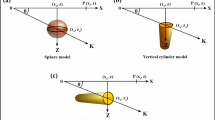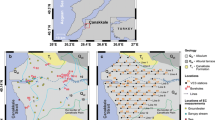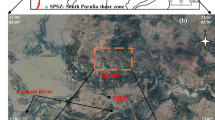Abstract
The redox field generated by electrically conductive minerals is one of the main constituents of self-potentials. It can be explained by electrochemical reactions in which conductors participate. The location and outline of seafloor hydrothermal ore deposits can be detected using marine self-potential anomalies that can be approximated through a marine geobattery model. The numerical modeling of marine self-potentials could be the foundation of corresponding data inversion and interpretation and improving the application effect of the self-potential method in detecting seafloor hydrothermal ore deposits. In this study, the inert electrode model and the on-land geobattery model are introduced to build the marine geobattery model, and the finite-infinite element coupling method is derived to deal with the truncated boundary problem effectively. Also, two tests are conducted to study the effect of model parameters on ground self-potential anomalies. A seafloor sulfide deposit model is built to study the self-potential characteristics. The numerical modeling results suggest that the precision and efficiency of the coupled method are superior to that of the traditional finite element method. Self-potential anomalies are greatly affected by medium resistivity, complex terrain, and amplitudes of embedded redox fields. Gradient changes in embedded redox fields do not cause significant self-potential anomalies but lead to mutations of current sources. The self-potential anomaly from the sulfide deposit model shows that the self-potential method can be effectively used to explore seafloor hydrothermal deposits that accompany negative self-potential anomalies above the ore bodies. The coupled method is quite suitable for multi-source models such as self-potential models.












Similar content being viewed by others
References
Ahmed, A. S., Jardani, A., Revil, A., & Dupont, J. P. (2013). SP2DINV: A 2D forward and inverse code for streaming potential problems. Computers & Geosciences, 59, 9–16.
Ahmed, A. S., Revil, A., Steck, B., Vergniault, C., Jardani, A., & Vinceslas, G. (2019). Self-potential signals associated with localized leaks in embankment dams and dikes. Engineering Geology, 253, 229–239.
Andrew, P. B. (2007). A graphical 3D finite element program for modelling self-potentials generated by flow through a porous medium. Journal of Environmental & Engineering Geophysics, 12(2), 185–197.
Astley, R. J., & Macaulay, G. J. (1994). Mapped wave envelope elements for acoustical radiation and scattering. Journal of Vibration and Acoustics, 170, 97–118.
Beaulieu, S., Baker, E., & German, C. (2015). Where are the undiscovered hydrothermal vents on oceanic spreading ridges? Deep Sea Research Part I, I, 121.
Becker, K., Von Herzen, R. P., Francis, T. J. G., Anderson, R. N., Honnorez, J., Adamson, A. C., Alt, J. C., Emmermann, R., Kempton, P. D., Kinoshita, H., Laverne, C., Mottl, M. J., & Newmark, R. L. (1982). In situ electrical resistivity and bulk porosity of the oceanic crust Costa Rica Rift. Nature, 300, 594–598.
Bigalke, J., & Grabner, E. W. (1997). The geobattery model: A contribution to large scale electrochemistry. Electrochimica Acta, 42(23–24), 3443–3452.
Brewitt-Taylor, C. R. (1975). Self-potential prospecting in the deep oceans. Geology, 3, 541–542.
Castermant, J., Mendonça, C. A., Revil, A., Trolard, F., Bourrié, G., & Lind, N. (2008). Redox potential distribution inferred from self-potential measurements associated with the corrosion of a burden metallic body. Geophysical Prospecting, 56(2), 269–282.
Constable, S., Kowalczyk, P., & Bloomer, S. (2018). Measuring marine self-potential using an autonomous underwater vehicle. Geophysical Journal International, 215, 49–60.
Corwin, R. F. (1976). Offshore use of the self-potential method. Geophysical Prospecting, 24, 79–90.
Cui, Y., Zhu, X., Chen, Z., Liu, J., & Liu, J. (2016). Performance evaluation for intelligent optimization algorithms in self-potential data inversion. Journal of Central South University, 23(10), 2659–2668.
Cui, Y., Liu, L., & Zhu, X. (2017a). Unscented Kalman filter assimilation of time-lapse self-potential data for monitoring solute transport. Journal of Geophysics and Engineering, 14(4), 920–929.
Cui, Y., Zhu, X., Wei, W., Liu, J., & Tong, T. (2017b). Dynamic imaging of metallic contamination plume based on self-potential data. Transactions of Nonferrous Metals Society of China, 27(8), 1822–1830.
Francis, T. J. G. (1985). Resistivity measurements of an ocean floor sulphide mineral deposit from the submersible Cyana. Marine Geophysical Researches, 7, 419–437.
Goto, T., Kondo, K., Ito, R., Esaki, K., Oouchi, Y., Abe, Y., & Tsujimura, M. (2012). Implications of self-potential distribution for groundwater flow system in a nonvolcanic mountain slope. International Journal of Geophysics, 2012, 640250.
Hannington, M. D., Jonasson, I. R., Herzig, P. M., & Petersen, S. (1995). Physical and chemical processes of seafloor mineralization at mid-ocean ridges. In S.E. Humphris, et al. (Eds.), Seafloor Hydrothermal Systems: Physical, Chemical, Biological and Geological Interactions. Geophys. Monogr. Ser., (vol. 91). Washington, DC: AGU.
Heinson, G., White, A., Constable, S., & Key, K. (1999). Marine self potential exploration. Exploration Geophysics, 30, 1–4.
Heinson, G., White, A., Robinson, D., & Fathianpour, N. (2005). Marine self-potential gradient exploration of the continental margin. Geophysics, 70, G109–G118.
Ikard, S. J., & Revil, A. (2014). Self-potential monitoring of a thermal pulse advecting through a preferential flow path. Journal of Hydrology, 519, 34–49.
Ikard, S. J., Teeple, A. P., Payne, J. D., Stanton, G. P., & Banta, J. R. (2018). New insights on scale-dependent surface-groundwater exchange from a floating self-potential dipole. Journal of Environmental & Engineering Geophysics, 23(2), 261–287.
Kaftan, I., Sindirgi, P., & Akdemir, O. (2014). Inversion of self potential anomalies with multilayer perceptron neural networks. Pure and Applied Geophysics, 171(8), 1939–1949.
Kawada, Y., & Kasaya, T. (2017). Marine self-potential survey for exploring seafloor hydrothermal ore deposits. Scientific Reports, 7, 1–12.
Kawada, Y., & Kasaya, T. (2018). Self-potential mapping using an autonomous underwater vehicle for the Sunrise deposit, Izu-Ogasawara arc, southern Japan. Earth, Planets and Space, 70, 142.
Marques, J. M. M. C., & Owen, D. R. J. (1984). Infinite elements in quasi-static materially nonlinear problems. Computers & Structures, 18(4), 739–751.
Mehdi, G., Qiu, X., Aidagulov, G., & Abbad, M. (2018). Streaming potential measurements for downhole monitoring of reservoir fluid flows: A laboratory study. Journal of Petroleum Science and Engineering, 161, 38–49.
Mendonça, C. A. (2008). Forward and inverse self-potential modeling in mineral exploration. Geophysics, 73, F33–F43.
Monecke, T., Petersen, S., Hannington, M., Grant, H., & Samson, I. (2016). The minor element endowment of modern sea-floor massive sulfides and comparison with deposits hosted in ancient volcanic successions. Reviews in Economic Geology, 18, 245–306.
Oliveti, I., & Cardarelli, E. (2019). Self-potential data inversion for environmental and hydrogeological investigations. Pure and Applied Geophysics, 176(8), 3607–3628.
Revil, A., & Jardani, A. (2013). The self-potential method: Theory and applications in environmental geosciences. Cambridge University Press.
Revil, A., Mendonça, C. A., Atekwana, E. A., Kulessa, B., Hubbard, S. S., & Bohlen, K. J. (2010). Understanding biogeobatteries: where geophysics meets microbiology. Journal of Geophysical Research: Biogeosciences, 115, G00G02.
Safipour, R., Hölz, S., Halbach, J., Jegen, M., Petersen, S., & Swidinsky, A. (2017). A self-potential investigation of submarine massive sulfides: Palinuro Seamount, Tyrrhenian Sea. Geophysics, 82(6), A51–A56.
Sato, M., & Mooney, H. M. (1960). Electrochemical mechanism of sulphide self-potentials. Geophysics, 25, 226–249.
Sheffer, M. R., & Oldenburg, D. W. (2007). Three-dimensional modelling of streaming potential. Geophysical Journal International, 169(3), 839–848.
Sindirgi, P., Pamukcu, O., & Ozyalin, S. (2008). Application of normalized full gradient method to self potential (SP) data. Pure and applied geophysics, 165(2), 409–427.
Stoll, J., Bigalke, J., & Grabner, E. W. (1995). Electrochemical modeling of self-potential anomalies. Surveys in Geophysics, 16, 107–120.
Titov, K., Revil, A., Konosavsky, P., Straface, S., & Troisi, S. (2005). Numerical modelling of self-potential signals associated with a pumping test experiment. Geophysical Journal International, 162(2), 641–650.
Ungless, R. F. (1973). An infinite element, M.S. thesis, University of British Columbia.
Upadhyay, A., Singh, A., Panda, K. P., & Sharma, S. P. (2020). Delineation of gold mineralization near Lawa village, North Singhbhum Mobile Belt, India, using electrical resistivity imaging, self-potential and very low frequency methods. Journal of Applied Geophysics, 172, 103902.
Von Herzen, R. P., Kirklin, J., & Becker, K. (1996). Geoelectrical measurements at the TAG Hydrothermal Mound. Geophysical Research Letters, 23, 3451–3454.
Wang, J., Tao, C., Wang, H., Deng, X., Xiong, W., & Li, Z. (2018). Study of self-potential observation ways in the seafloor polymetallic sulfide deposits. Haiyang Xuebao, 40, 57–67.
Xie, J., Cui, Y., Guo, Y., Zhang, L., Fanidi, M., & Liu, J. (2020a). 2.5D self-potential forward modeling by natural-infinite element coupling method. Journal of Applied Geophysics, 179, 104077.
Xie, J., Cui, Y., Zhang, L., Guo, Y., Wang, J., Fanidi, M., & Liu, J. (2020b). Numerical modeling of biogeobattery system from microbial degradation of underground organic contaminant. SN Applied Sciences, 2, 208.
Xie, J., Cui, Y., Zhang, L., Ma, C., Yang, B., Chen, X., & Liu, J. (2020c). 3D forward modeling of seepage self-potential using finite-infinite element coupling method. Journal of Environmental & Engineering Geophysics, 25(3), 381–390.
Yuan, Y., Qiang, J., Tang, J., Ren, Z., & Xiao, X. (2016). 2.5D direct-current resistivity forward modeling and inversion by finite-element-infinite-element coupled method. Geophysical Prospecting, 64(3), 767–779.
Zhu, X., Cui, Y., Li, X., Tong, T., & Ji, T. (2015). Inversion of self-potential anomalies based on particle swarm optimization. Journal of Central South University (Science and Technology), 46(2), 579–585.
Zhu, Z., Tao, C., Shen, J., Revil, A., Deng, X., Liao, S., Zhou, J., Wang, W., Nie, Z., & Yu, J. (2020). Self-potential tomography of a deep-sea polymetallic sulfide deposit on southwest Indian ridge. Journal of Geophysical Research: Solid Earth, 125, e2020JB019738.
Zlotnicki, J., Vargemezis, G., Johnston, M. J. S., Sasai, Y., Reniva, P., & Alanis, P. (2017). Very-low-frequency resistivity, self-potential and ground temperature surveys on Taal volcano (Philippines): Implications for future activity. Journal of Volcanology and Geothermal Research, 340, 180–197.
Funding
This study was funded by the National Natural Science Foundation of China (grant number 41874145, 72088101).
Author information
Authors and Affiliations
Corresponding author
Ethics declarations
Conflict of interest
The authors declare that they have no conflict of interest.
Additional information
Publisher's Note
Springer Nature remains neutral with regard to jurisdictional claims in published maps and institutional affiliations.
Rights and permissions
About this article
Cite this article
Xie, J., Cui, Ya., Fanidi, M. et al. Numerical Modeling of Marine Self-Potential from a Seafloor Hydrothermal Ore Deposit. Pure Appl. Geophys. 178, 1731–1744 (2021). https://doi.org/10.1007/s00024-021-02720-3
Received:
Revised:
Accepted:
Published:
Issue Date:
DOI: https://doi.org/10.1007/s00024-021-02720-3




